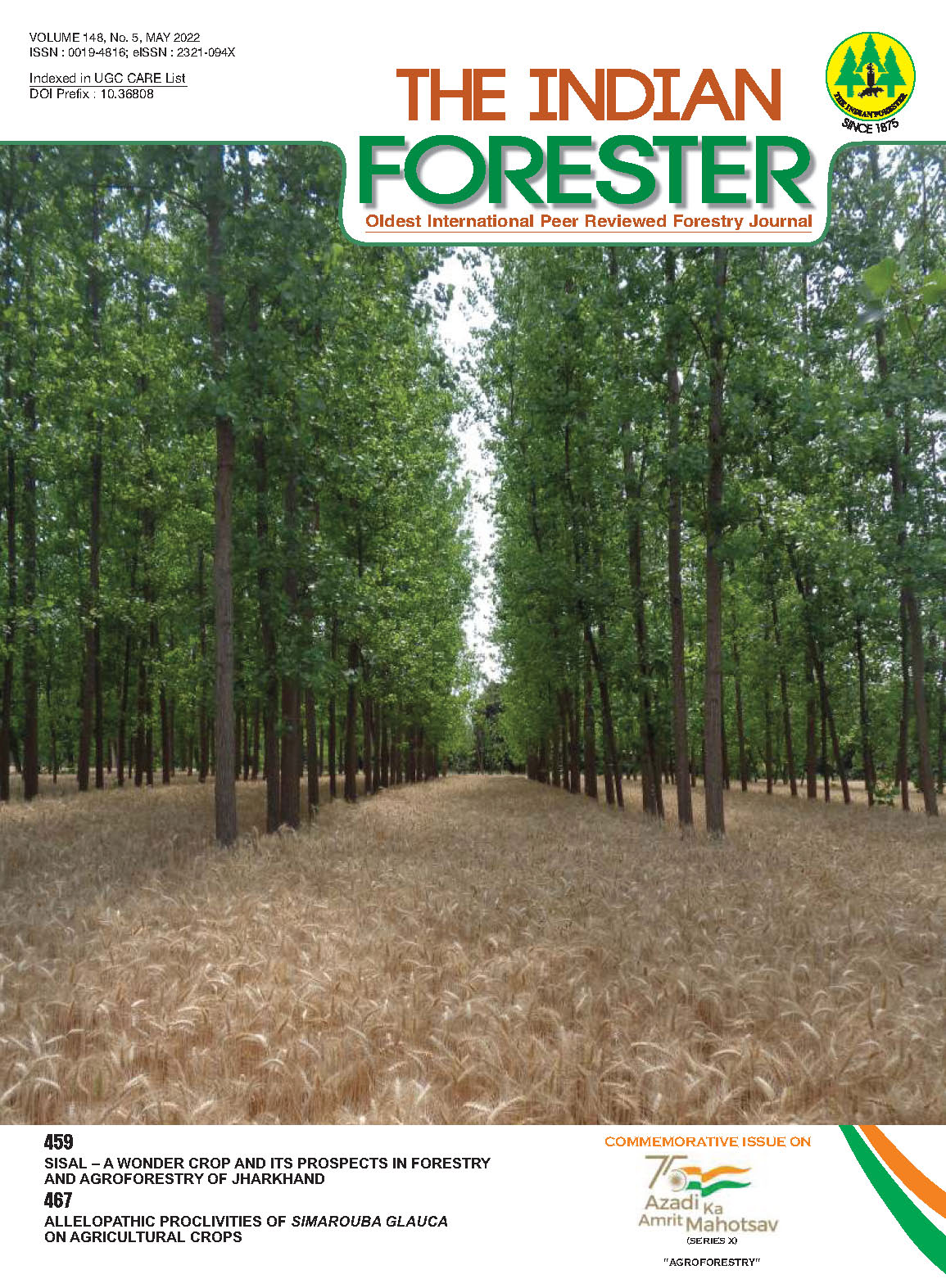Allelopathic Proclivities of Simarouba glauca on Agricultural Crops
DOI:
https://doi.org/10.36808/if/2022/v148i5/155362Keywords:
Simarouba glauca, Allelochemicals, Allelopathic effect, Agricultural cropsAbstract
In this study, the allelochemicals present in the leachates of bark, fresh leaves, leaf litter and root of Simarouba glauca were identified using Gas Chromatography. The results revealed that the following allelochemicals viz., benzoic acid, caffeic acid, catechol, coumaric acid, ferulic acid, resorcinol, salicylic acid and vanillic acid were present in the leachates. The bioassay of identified allelochemicals were tested on germination, seedling growth and vigour index of the following agricultural crops viz., blackgram, greengram, cowpea and redgram. The results reported that all the allelochemicals exhibited reduction in germination and growth of pulse crops. Among the allelochemicals, ferulic acid and salicylic acid exhibited maximum inhibitory effect on germination of the test crops at 1mM and 2mM concentrations respectively when compare to control. The maximum inhibitory effect on seedling growth and vigour index was registered by ferulic acid at both concentrations. Among the test crops, redgram was most affected and cowpea was least affected due to allelochemicals.
References
Abdul Baki A.A. and Anderson J.D (1973). Vigour determination in soyabean and seed multiple criteria, Crop Science, 13: 630-633.
Gantzer E. (1960). Wirkungen Von Kumarin and Wachstums and Entmicklung Svorgang and since Wanderrungs. Fahigkeit in Pjinzengewele. Planta, 55: 235.
ISTA (1986). International rules for seed testing. International Seed Testing Association (ISTA). Seed Science & Technology, 24 (Supplement) Zurich, Switzerland. 136 pp.
Mahadeva A. and Sridhar R.S. (1980). Methods in physiological plant pathology. Sivakami publications, Madras. Pp 92-94.
Manasi P and Gaikwad D.K. (2011). A critically important oil yielding plant Laxmitaru (Simarouba glauca D.C.). Journal of Pharmaceutical Sciences and Research, 3(4): 1195-1213.
Mohan Raj, T. (2004). Studies on the compatibility of agricultural crops with Simarouba glauca. M.Sc thesis, Tamil Nadu Agricultural University, Coimbatore, India.186 pp.
Moktar Hossain Md., Giashuddin Miah, Tofayel Ahamed and Noor Shaila Sarmin. (2012). Allelopathic effect of Moringa oleifera on the germination of Vigna radiata. International Journal of Agriculture and Crop Sciences, 4(3): 114-121.
Murugesan D. (2003). Studies on the allelopathic proclivities of important agroforestry trees on agricultural crops. M.Sc. Thesis, TNAU, Coimbatore, India. 162 pp.
Naresh Kumar, Handa A.K., Inder Dev, Asha Ram, Lal Chand and Ashok Shukla (2018). Allelopathic effect of aqueous leaf extract of Melia dubia on seed germination and growth of Zea mays. Bulletin of Environment, Pharmacology and Life Sciences, 7(12) : 55-60.
Panneer Selvam R., L. Karikalan and S. Rajan (1998). Allelopathic effect of Tectona grandis leaf and root extracts on Arachis hypogea and Zea mays. In: Abstract No. 132, Allelopathy Journal, 6(1): 137.
Panse V.C. and Sukhatme P.V. (1967). Statistical methods for agricultural workers. 2nd edition, ICAR, New Delhi. 328pp.
Pravin R., Narkhede S.S., Rane A.D., Mhaiske V.M. and Dalvi V.V. (2018). Allelopathic effect of solid bamboo (Dendrocalamus stocksii munro.) on cowpea (vigna unguiculata). Indian Forester, 144(3): 238-242.
Rajendra Prasad, Tripathi V.D., Prashant Singh, Handa A.K., Alam B., Ramesh Singh and Chaturvedi O.P. (2016). Allelopathic potential of Butea monosperma L.: Effect of aqueous leaf extract on seed germination and seedling growth of winter season (rabi) crops. Indian Journal of Agroforestry, 18(1): 63-69.
Rice E.L. (1984). Allelopathy. New York, USA Academic Press, 2nd edition.422pp Richardson D.R. and Williamson G.B. (1988). Allelopathic effects of shrubs of the sand pine scrub on pines and grasses of the sand hills. Forest Science, 24(3): 592-605.
Sasi Kumar K., Vijayalakshmi C. and Parthiban K.T. (2002). Allelopathic effects of Eucalyptus on Blackgram (Phaseolus mungo L.). Allelopathy Journal, 9: 205-214.
Sirawdink Fikreyesus., Zerihun Kebebew, Amsalu Nebiyu, Nardos Zeleke and Seife Bogale (2011). Allelopathic Effects of Eucalyptus camaldulensis Dehnh. on germination and growth of tomato. American-Eurasian Journal of Agricultural and Environmental Science, 11(5): 600-608.
Sivagurunathan M., Sumitra Devi G. and Ramasamy K. (1997). Allelopathic compound in Eucalyptus spp. Allelopathy Journal, 4(2): 313-320.
Sivagurunathan M. (1997). Allelopathic studies in three Eucalyptus species on some field crops. M.Sc. Thesis, Tamil Nadu Agricultural University, Coimbatore, 240pp
Srivastava J.P.L. (1996). Prosopis juliflora: A tree for the arid and semiarid zone of Rajasthan. International tree crops journal, 7: 1-16.
Tripathi S., Ashutosh T. and Kori D.C. (1999). Alleloapthic evaluation of Tectona grandis leaf root and soil aqueous extracts on soybean. Indian Journal of Forestry, 22(4): 366-374.
Tripathi S., A. Tripathi, D.C. Kori and Paroha S. (2000). Effect of Dalbergia sissoo extracts, rhizobium and nitrogen on germination, growth and yield of Vigna radiata. Allelopathy Journal, 7(2): 255-264.
Vaughan D. and Ord B.G. (1990). Effects of allelochemicals in roots, plant root growth - An ecological perspective. Blackwell Scientific Publications, London. pp. 399-421
Whitehead D.C., Dibb H. and Hartley R.D. (1983). Bound phenolic compounds in water extracts of soil, plant roots and leaf litter. Soil Biology and Biochemistry, 15: 133-136.
Downloads
Downloads
Additional Files
Published
How to Cite
Issue
Section
License
Unless otherwise stated, copyright or similar rights in all materials presented on the site, including graphical images, are owned by Indian Forester.





